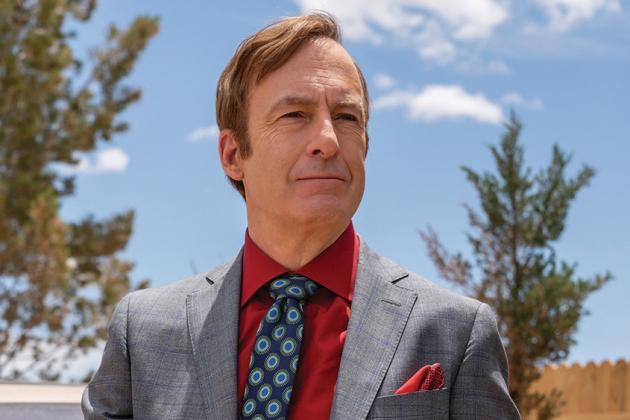
Spoiler alert: This review contains spoilers for “Saul Gone,” the series finale of “Better Call Saul.”
It turns out that there was one person the once and future Jimmy McGill would put ahead of his own self-interest.
More from Variety
In the striking and elegant finale to one of TV’s most consistently strong dramas of the past decade, Bob Odenkirk’s Saul Goodman, to borrow a phrase, broke good. Having finally been apprehended, Saul structured a plea bargain that would have him in and out of prison in a plausibility-stretching-but-who’s-counting seven years. But then he saw and took an opportunity to clear the name of his ex-wife Kim Wexler (Rhea Seehorn), and to reclaim his real name, the one he used before “Saul” committed himself to full-time chicanery. Jimmy will almost certainly spend the rest of his life behind bars, in the knowledge that he was delivered there in a moment of grace.
The end of this spinoff of “Breaking Bad,” some fourteen years after the mothership debuted on AMC, marks the likely end of this creative universe. And the “Saul” ending fits into Vince Gilligan and Peter Gould’s puzzle with a slight, intriguing tension. The vision of “Breaking Bad” was pitch-dark. That show’s conclusion, with the warped criminal Walter White achieving everything he wants before dying, serene in the knowledge that he was perfect, gave fans perhaps too much of what they may have wanted. Now, that show’s spinoff denies us the juicy pleasure of seeing Saul pull off one last big score, forcing us to reckon with the more complicated satisfactions of suffering for having done the right thing.
This finale felt meticulous, from the way it pulled in on Saul’s moral crisis — with the chaos of various ancillary characters involved in the drug trade now simply a list of crimes for which Saul must answer — to the deployment of key supporting characters to make its points. Odenkirk has likely never been stronger than in the courtroom scene, seeming utterly certain in his decision to use his lawyering skills on someone else’s behalf and yet quietly thrilled that the scheme is working.
Seehorn’s performance as Kim remains incandescent, with her pretending to be her ex-husband’s lawyer in order to share a final cigarette in prison a melancholy reminder of all the grifts they pulled together in happier times. While I’ve, at times, found direct allusions to “Breaking Bad” on “Better Call Saul” to be somewhat clumsy, this episode’s flashback cameo of Bryan Cranston as Walter earned its place. “So you were always like this,” the kingpin tells his attorney, as the pair discuss an early slip-and-fall scam Saul pulled. Walter was forced into a life of crime, or so he tells himself; Saul was born for it.
Their discussion takes place within the context of Saul waxing unusually philosophical; he’s wondering if Walter has any regrets. (If I have one note about this scene, it’s that Cranston makes a bit too much of a meal out of Walter’s refusal to understand the question; I’ve become accustomed to the less jagged rhythms of Odenkirk’s lead performance and of “Better Call Saul” generally.) Later, Michael McKean returns for another retrospective scene, playing Chuck, the brother Jimmy betrayed. The scene McKean and Odenkirk share is sweet and sorrowful for what lies ahead; it’s imbued with a promise that Jimmy will care for his brother, one we know he doesn’t keep. Jimmy notices that Chuck is reading the novel “The Time Machine.”
This finale operates a bit like a time machine, too, and not merely for its skips throughout moments in Jimmy’s life. Nearly nine years ago, after a flurry of anticipation, “Breaking Bad” ended in strikingly imperfect fashion. Its tidiness made the episode a tightly constructed narrative machine, but the easy resolution lacked grit and texture. It’s perhaps unsurprising that series creator Vince Gilligan has repeatedly undertaken attempts to embroider more of the story. He’s done so with the feature-length film “El Camino,” which follows Jesse Pinkman (Aaron Paul) after the events of “Breaking Bad,” and now with the story of Saul, which gave him and Peter Gould (who wrote and directed the episode) a second chance at a series finale.
“Saul” was, to this viewer, an achievement that might never have been made without its predecessor series and one that improved upon it. Its treatment of “Slippin’ Jimmy” falling away from grace hit notes of sorrow that the more operatic “Breaking Bad” couldn’t quite achieve. (And, not for nothing, but this show had a better sense of humor.) The finale ratifies that sense once and for all, with the baleful parting of Jimmy and Kim — once united against the world, now separated by a prison wall, and the knowledge that one escaped their mutual pull towards the thrill of wrongdoing, but one couldn’t, quite — matching anything from “Breaking Bad.” It might not have registered, though, for it spoke in glances rather than shouts. The last we see of Jimmy is what Kim sees of him, a man who’d look like a ghost to her even if he weren’t so definitively a part of her past. The camera tracks her gaze as a prison wall blocks him from view, and he is gone.
In all, “Saul” will be remembered as an achievement from an era of television that seemed to have ended before the show itself did: It had a willingness to putter around the edges of its story and a faith in its audience that recalled, say, “The Americans,” something that’s far less in evidence among newer series today. (Notably, it’s a tie to AMC’s era as an emergent driving force in adult dramas, an era that, pending a Sally Draper prequel series at some future date, seems to have wound down.) The show’s willingness, especially in its last stretch of episodes, to alternate major and striking moments with quotidian sequences of characters’ ordinary existences — a conversation with a bartender, a day at the office — that seemed to run just a little too long was a striking choice. It had the texture of real life, which is perhaps not what one would expect to be seeking from a show about a corrupt lawyer enmeshed in cartel wars.
And yet that’s what made it work to its last moments. The show’s willingness to be repetitious and have Saul begin the story of his fall for a second time in the final episode before a judge, just so that he can alter the story enough to let Kim off the hook, is played long. It’s a tease that delivers all the more once viewers realize what’s happening. And it’s the last act in an inversion of what we’d seen on “Breaking Bad,” a six-season long confidence game: Those who thrilled to Walter White’s transformation into Scarface got to watch the endless capering of a man who literally could not help himself from doing wrong, who needed to pull cons even while trying desperately hard to remain incognito. And at the last moment, we see what he’s been hiding all along: A human heart.
Best of Variety
Sign up for Variety’s Newsletter. For the latest news, follow us on Facebook, Twitter, and Instagram.




